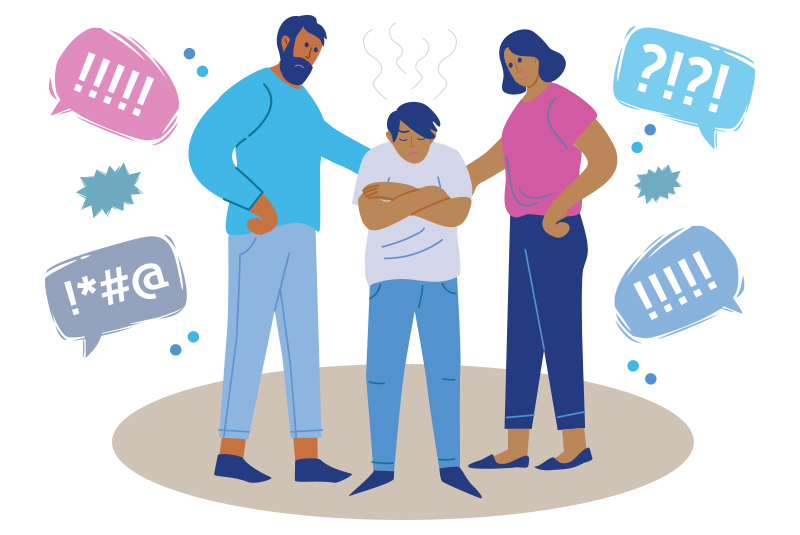Talking to your child about slurs: When words hurt

Imagine the following scenarios:
- You’re walking down the street with your teenage son and an adult in a passing car yells a racial slur out the window at you.
- You’re at your local playground you overhear your daughter direct an anti-gay slur at another child.
As a parent, what do you do?
“These conversations are often not easy to have with our children, but they’re really important,” says Nikki Tennermann, a social worker and administrative director of the Office of Health Equity and Inclusion at Boston Children’s Hospital.
Tennermann says that when children hear slurs directed at them, their family members, or someone in a similar group, it can have a negative effect on their identity development. “It can lead to negative internalized feelings, and make them feel like something is bad or different about them.”
So, how do you have these conversations with your children? For help, we turned to Tennermann and her colleagues, Rehana Rahman, a clinical social worker in the AWAKE Program at Boston Children’s Hospital, and Haidee Cano, a clinical social worker at the Martha Eliot Health Center.
What can a parent do if a slur is directed at their child?
Tennermann: I would remind parents to stay calm. If it seems like the situation might be volatile, walk away. It’s better to teach your kids to walk away and be safe, and talk with them privately when you’re in a safe place. Walking away is not teaching your child that slurs are okay — it’s teaching them about safety and resilience in the face of hatred.
Rahman: It also depends in part on the context. If it’s another child using the slur, the parent could step in and intervene, but only if they feel comfortable doing so. You could explain to the child that the word they said is hurtful. If this is happening in a school setting, whether in the classroom or on the playground, you should bring it to the attention of the school administration.
Cano: I think it’s always best to come from a place of curiosity, such as asking if they know what that word means. Sometimes kids say these words because they think it’s funny and don’t really understand the meaning behind it. If this is the case, you can explain that the word isn’t humorous and is actually hurtful. You can also teach your kids to use a similar retort with other kids, such as, “We don’t use words like that. It’s inappropriate and unkind.” Or “I don’t appreciate you using that word or I don’t appreciate you calling me that.”
What do you say to your child after such an incident?
Tennermann: For young children, focus on what is fair or just. You can tell them that it’s not fair for people to make assumptions about them based on their race or color of their skin. It’s also a good time to reinforce positive thinking about themselves. For example, you could say something like, “We are proud of our heritage and identity, and even if people say hurtful things, it doesn’t affect who we are.”
For preteens and older kids, you can ask them what they know about these words and how it makes them feel. Have an open discussion about your own feelings, and reinforce that it’s not right for others to use hurtful words.
Cano: If your child or another child in your life experiences a slur and comes to you about it, remember to validate their experience and their feelings in that moment. That piece is huge.
What if your child is the one using a slur?
Tennermann: First, I would set clear expectations that you are not okay with it. You can say something like, “this is not language we use in our household.” Then you can explain why these words are hurtful. For example, I recently talked about anti-Asian hate with my daughter and explained that just as we don’t want people to treat us differently because we’re Black, we don’t treat people differently because they’re Asian.
A helpful reading list
Reading with your child is another good way to bring up topics about empathy and race. Here are some suggestions from Rehana Rahman:
Books that reflect themes of empathy, accepting, and differences:
- The Day You Begin by Jacqueline Woodson & Rafael Lopez
- Spaghetti in a Hot Dog Bun by Maria Dismondy
- The Name Jar by Yangsook Choi
- Antiracist Baby Picture Book by Ibram X. Kendi
Books that explicitly deal with racism:
- Something Happened in Our Town: A Child’s Story About Racial Injustice by Marianne Celano, Marietta Collins, and Ann Hazzard
- Separate is Never Equal: Sylvia Mendez and Her Family’s Fight for Desegregation by Duncan Tonatiuh
- The Lying Liar Called Racism by Giselle Fuerte
- Stamped: Racism, Antiracism, and You by Jason Reynolds and Ibram X. Kendi
Cano: You can also approach this conversation from a place of curiosity. Ask questionsso you can understand where this is coming from. Start by asking your child where they heard the word and if they know what it means. You can then explain why it shouldn’t be used, such as the history of the word, if known, and how oftentimes these words are rooted in misinformation. In some cases, kids pick up this language from someone else in the family. If this is the case, you may need to have a difficult conversation with other family members and reiterate what your values are as family.
Teaching children the difference between intention versus impact is important. “Even if it was not your intention to hurt your friend with your words, the impact you had is that you hurt them.” Children should take ownership of their wrongdoing and apologize to the person it was directed towards. And for older children, you can follow-up these conversations with more in-depth conversations about historical events surrounding ignorance and bigotry.
Rahman: If racism and bigotry isn’t part of a discussion at home or within the school setting, sometimes children don’t know slurs are not appropriate. At home you can create a space of curiosity by allowing children to ask questions. And if your school is not talking about racism and bigotry, suggest they do. For example, they can have kids talk about what it’s like to come from different backgrounds and celebrate their differences.
What else can parents do?
Tennermann: As Rehana said, I think it’s important to have regular conversations about racism and bigotry in your family. Talk about the fact that racism and bigotry exist, even if it doesn’t affect your family. These are hard topics you might not want to address with your kids, but these are conversations that need to happen.
Rahman: Families who hold marginalized identities are already having a lot of these discussions, but we need to shift the focus to those in the dominant culture. Those families need to have these conversations as well.
Cano: Even if you have never had to deal with racism directly, you can still think about a time you were treated differently because of your gender or another trait. You can talk about that with your kids and how that experience made you feel. There are also some online resources that also offer helpful tips for parents, including the American Psychological Association and PBS.
Rahman: I also want to mention that it’s important to take care of yourself. These discussions can be incredibly difficult, especially for parents who are triggered because of their own experiences. If you need help, make sure to seek out support for yourself.
Read more on racism and the Office of Health Equity and Inclusion at Boston Children’s.
Related Posts :
-

Medical care for youth with neurodevelopmental disabilities: A call for change
According to national data, one in six children has a neurodevelopmental disability (NDD) such as autism, intellectual disability, or ADHD. ...
-

Revisiting race and ethnicity in clinical guidelines
Health care institutions often rely on clinical pathways in assessing patients and making decisions about their care. Some of these ...
-

Helping clinicians embrace family-centered rounds
If you’ve ever been hospitalized, you may have experienced this: groups of doctors coming in and talking about you ...
-

Infantile spasms: Speeding referrals for all infants
Infantile epileptic spasms syndrome (IESS), often called infantile spasms, is the most common form of epilepsy seen during infancy. Prompt ...





